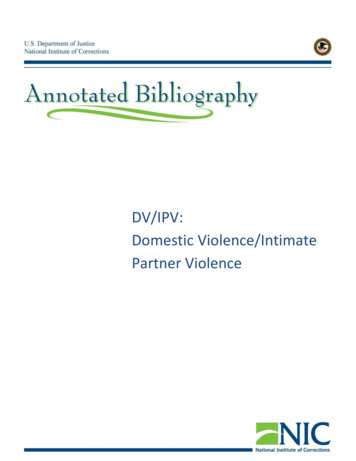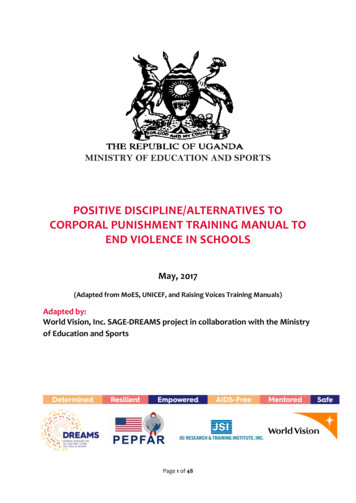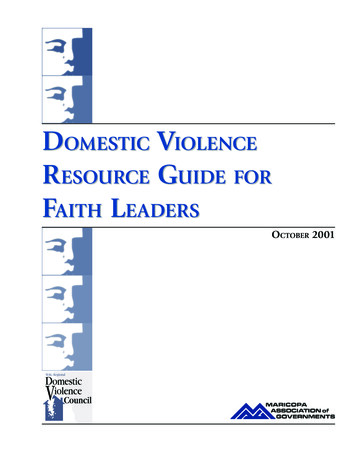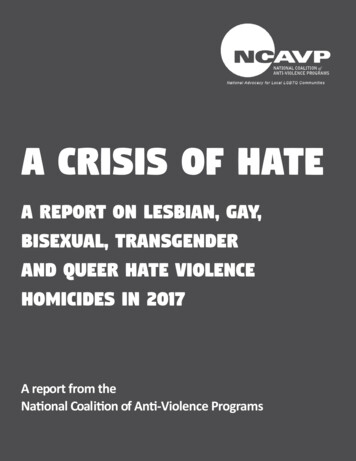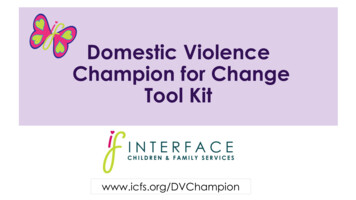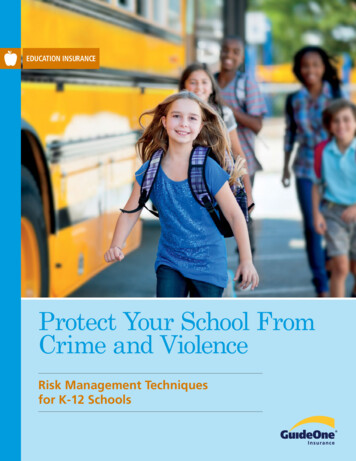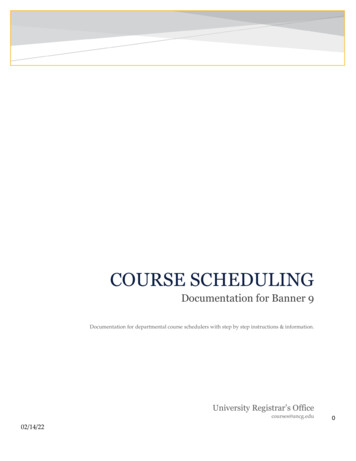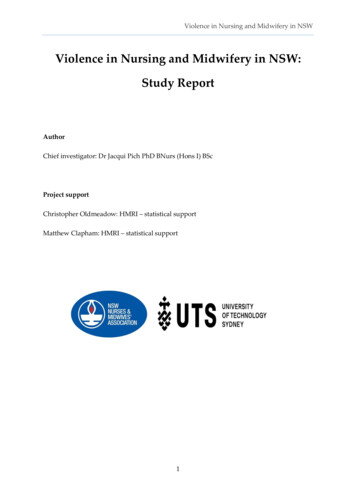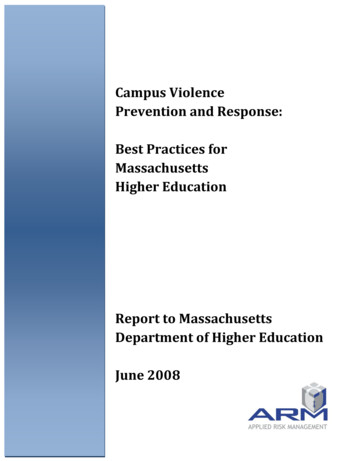
Transcription
Campus ViolencePrevention and Response:Best Practices forMassachusettsHigher EducationReport to MassachusettsDepartment of Higher EducationJune 2008
Principal ContributorsDaniel O’NeillPresident and CEO, Applied Risk ManagementJames Alan Fox, Ph.D.The Lipman Family Professor of Criminal Justice and Professor of Law,Policy and Society, Northeastern UniversityRoger Depue, Ph.D.Forensic Behavioral Scientist – Founder, The Academy Group, Inc.Elizabeth Englander, Ph.D.Professor of Psychology and Director of Massachusetts AggressionReduction Center, Bridgewater State College
Executive SummaryPervasive media images of mass shootings at Virginia Tech and Northern IllinoisUniversity have raised the specter of serious violence on college campuses. But by anymeasure, the risk of serious violence on campus is remarkably low, particularly in itsmost extreme form. Although the chances of serious violence may be remote, thepotential consequences can be devastating and long-lasting. Colleges must respondproactively to the risk, as parents rightly expect a special level of care for their sonsand daughters while they are away at school. Thus, it is prudent and imperative thatcolleges take reasonable steps to ensure the safety of students as well as faculty andother employees.While shootings may be the most visible form of campus violence, they are clearly notthe most commonplace. Security practices must also focus on other, more prevalent,forms of violence such as sexual and physical assault. Current best practices, taken incombination with research, demonstrate the essential role of collaboration among allservice providers in the prevention of violent incidents on college campuses.This report has four major sections. First, we define the nature and scope of campusviolence both nationally and in Massachusetts. Next, we review previous reports ofstudy groups and task forces and discuss established best practices for enhancingcampus safety and violence prevention. Third, we examine the current state ofsecurity and violence prevention at institutions of higher education throughoutMassachusetts based upon a survey conducted of public colleges and universities.Finally, by comparing these results with established best practices, we advance 27recommendations for how Massachusetts schools can best improve their security andviolence prevention efforts. Below are the key findings from each of the foursections.Section One: Definition of the National/Massachusetts Landscape1. Violent crime, particularly homicide, is extremely rare both nationally and inMassachusetts.2. Of the 13 fatal mass shootings that have occurred at American collegecampuses since 1990, eight were perpetrated by current or former studentsfrom graduate or professional schools. Therefore, graduate studentdisgruntlement should be a particular focus for higher education officials.3. Violent crime at Massachusetts public colleges and universities typically takesplace within dormitories, occurs late at night, is argument-related, entailslittle or no injury to the victim, and involves a victim and offender who knoweach other.i
Section Two: Previously Established Best Practices for Campus Safety and ViolencePrevention1. A set of “best practices” recommendations were found to be common among20 previous reports on campus violence produced by work groups and taskforces from around the country. These were:a. Create an all-hazards Emergency Response Plan (ERP)b. Adopt an emergency mass notification and communications systemc. Establish a multi-disciplinary team to respond to threats and otherdangerous behaviorsd. Review and train personnel regarding privacy/information sharing lawsand policies such as FERPA and HIPAAe. Have an MOU with local health agencies and other key partners in thecommunityf. Practice emergency plans and conduct trainingg. Educate and train students, faculty, and staff about mass notificationsystems and their roles and responsibilities in an emergencyh. Educate faculty, staff, and students about recognizing and responding tosigns of mental illness and potential threatsi. Conduct risk and safety assessmentsj. Have an interoperable communication system with all area respondersk. Ensure that all responder agencies are trained in the National IncidentManagement System (NIMS) and the Incident Command System (ICS)2. Site visits to five Massachusetts public colleges and universities highlighted thatparticular campuses had:a. Received free on-site training by the FBI for interpreting violent writingsb. Installed CCTV cameras and an extensive electronic access controlsystemc. Received free on-site Active Shooter Response Training conducted by theMassachusetts State Policed. Implemented comprehensive mass notification systems, including e-mail,text messaging, voice messaging, and web-based alerts, with one schoolhaving 100% enrollmente. Issued advanced equipment to campus police officers, includingweapons, vehicles, and communication systemsf. Conducted weekly Threat Assessment Team meetings that includedmembers from campus police, residential life, counseling services,faculty, and the graduate and undergraduate school deansSection Three: Existing Campus Safety and Violence Prevention Practices inMassachusetts1. Eighty-three percent of the schools provide on-campus mental health servicesfor students, and of these schools, 57 percent provide specialized services(e.g., substance abuse, suicide prevention, eating disorders) rather than justgeneralized servicesii
2. Eighty-one percent of the schools do not submit potentially violent writings,drawings and other forms of individual expression to a forensic behavioralscience expert for review3. Over half of the schools (58%) have exterior doors that are in need of repair orreplacement4. Fifty-four percent of schools do not employ CCTV cameras on campus5. Fifty-two percent of schools train their campus police officers in active shooterresponse tactics6. Sixty-four percent of schools have never conducted active shooter drills7. Eighty-four percent of schools have campus police officers who carry “lessthan-lethal” weapons, and only one-third have police officers who carryfirearms8. All schools report having mass notification technology9. Forty-one percent of schools report that their communications equipment isnot interoperable with local law enforcement agencies, and two-thirds reportthat their communications equipment is not interoperable with Federal lawenforcement or emergency management agencies10. One-third of the schools do not have a formal policy in place regarding whatfaculty and staff should do if they have concerns about a student or colleaguewho appears to have the potential for becoming violent11. Seventy percent of schools do not specifically train faculty and staff on how torecognize risk factors for students and employees who may pose a risk ofviolence12. Eighty-eight percent of schools have not conducted a vulnerability assessmentof their campus13. One-third of schools do not have a mutual aid agreement with neighboring lawenforcement agencies, and 48 percent do not have mutual aid agreements withsurrounding communities for emergency medical training or support14. All schools report having an Emergency Response Plan (ERP)15. Sixty-five percent of the schools have a Threat Assessment Team (TAT)16. Sixty-five percent of the schools report that they do not have a trainedbehavioral health Trauma Response TeamSection Four: Recommendations for Campus Safety and Violence Prevention1. Early Detection and PreventionRecommendation #1: Campus mental health services should be clearlyavailable and easily accessible to students.Recommendation #2: Schools should offer specialized mental health services,not just generalized services.Recommendation #3: Writings, drawings, and other forms of individualexpression reflecting violent fantasy and causing a faculty member to beiii
fearful or concerned about safety, should be evaluated contextually for anypotential threat.2. Physical and Electronic SecurityRecommendation #4: Schools should ensure that all exterior doors areproperly constructed and lockable.Recommendation #5: Schools should develop a reasonable plan for electronicaccess control in the event of an emergency.Recommendation #6: Schools should install CCTV cameras throughout theircampuses.Recommendation #7: Schools should equip all classrooms with emergencysignaling/notification capabilities.3. Campus Police DepartmentRecommendation #8: Campus police departments should have up-to-dateactive shooter response plans in place and train their officers in active shooterresponse tactics.Recommendation #9: Campus safety staffing levels should be adequate for thesize and character of the school.Recommendation #10: Sworn campus police officers should be armed andtrained in the use of personal or specialized firearms.Recommendation #11: Schools should ensure that the campus policedepartment has the equipment necessary to gain forcible entry into lockedbuildings and classrooms.4. Mass NotificationRecommendation #12: Schools should have a communications system that isinteroperable with outside agencies.Recommendation #13: Schools should establish a formal policy for use of theirmass notification system.5. Policies and ProceduresRecommendation #14: Schools should have in place a formal policy outlininghow and to whom faculty and staff should refer students who appear to havethe potential for becoming violent.iv
Recommendation #15: Faculty and staff should receive training in identifyingstudents at risk.Recommendation #16: Faculty and staff should receive training in managingdifficult interactions and situations.Recommendation #17: Faculty and staff should be informed about theappropriate protocol in the event of a crisis.Recommendation #18: Schools should include public safety as part of theorientation process.Recommendation #19: Graduate student applicants should be directly queriedregarding any unusual academic histories, as well as criminal records anddisciplinary actions.Recommendation #20: Schools should conduct vulnerability assessments atleast once per year.Recommendation #21: Schools should form mutual aid agreements or haveMemoranda of Understanding (MOU’s) with agencies in the community havingnecessary support resources, such as mental health service providers,emergency medical response services, and law enforcement agencies.Recommendation #22: Schools should have multiple reporting systems thatpermit campus community members to report suspicious behavior anonymouslyand conveniently.6. Emergency ResponseRecommendation #23: Every college and university should review and updateits Emergency Response Plan (ERP) on a regular basis.Recommendation #24: Every school should form, train and maintain a ThreatAssessment Team (TAT).Recommendation #25: The TAT should consist of representatives from variousdepartments and agencies, minimally comprised of student services andcounseling staff, faculty, police, human resources personnel, and legal counsel.Recommendation #26: Each school should have a trained behavioral healthTrauma Response Team (TRT), either on campus or through a contract orformal agreement.v
Recommendation #27: Schools should plan for victim services and aftermathissues.This review of best practices and current research underlines the need for careful andmeasured planning for campus safety. Campus safety is not simple or universal; itrequires an analysis of each school’s unique situation, character, setting, population,and mission. The recommendations in this report should not be addressed in isolation;rather, they should be considered in the broader context of the campus's approach toprevention and security and should take into account the views and perspectives of awide array of stakeholders in consultation with professionals and experts. Suchcollaborative efforts may ultimately offer the soundest security and safety plan forany institution of higher education.vi
Campus Safety and Violence Prevention Work GroupThe Campus Safety and Violence Prevention Work Group, identified below, representsa joint effort by the Department of Higher Education, the Executive Office of PublicSafety and Security, the Executive Office of Health and Human Services, and theOffice of the Attorney General, to analyze the causes of campus-based violence andmake recommendations regarding campus safety and violence prevention.NameMary Ellen AshleyLester BlumbergTammy BringazeKevin BurkeFrederick ClarkLayla D’Emilia-ShepherdMary Jane EnglandLinda JonesJim JulianoBarbara LeadholmRyan McCarthyClantha McCurdyBarbara O’ConnorEileen O’ConnorCarlene PavlosPatricia PlummerShane RodriguezMary SullivanJoseph SullivanPeter TsaffarasLeonard Von FlaternInstitution/OrganizationNorthern Essex Community CollegeMA Department of Mental Health, General CounselWestfield State CollegeSecretary, Executive Office of Public Safety & SecurityDepartment of Higher EducationLegislative Section, EOPSRegis CollegeSalem State CollegeBunker Hill Community CollegeMA Department of Mental Health, CommissionerMA Art, Campus PoliceDepartment of Higher EducationUMass Amherst PoliceDepartment of Higher EducationMA Department of Public Health, Director, Violence & Injury PreventionDepartment of Higher EducationSalem State College, Campus PoliceCommunity Information & Education Division, AGODepartment of Higher EducationDepartment of Higher EducationMA State Policevii
Campus Safety and Violence Prevention Work GroupCampus LiaisonsThe individuals listed below were points of contact for collecting various data andreports from the Massachusetts public colleges and universities.InstitutionBerkshire Community CollegeBristol Community CollegeBunker Hill Community CollegeCape Cod Community CollegeGreenfield Community CollegeHolyoke Community CollegeMass Bay Community CollegeMassasoit Community CollegeMiddlesex Community CollegeMount Wachusett Community CollegeNorth Shore Community CollegeNorthern Essex Community CollegeQuinsigamond Community CollegeRoxbury Community CollegeSpringfield TechBridgewater State CollegeFitchburg State CollegeFramingham State CollegeMass College of ArtMass College of Liberal ArtsMA Maritime AcademySalem State CollegeWestfield State CollegeWorcester State CollegeUMass AmherstUMass BostonUMass DartmouthUMass LowellUMass WorcesterName(s) of ContactPaul SwearenginSteve KenyonJames JulianoPhillip RyanBill MayroseRalph GouldKim GazzolaCarl KowalskiPatrick CookEdward TerceiroDouglas PuskaMary Ellen AshleyKevin RitaccoThomas GalvinDavid SianoDavid TillinghastJames HamelBrad MedeirosDwayne FarleyJoseph CharonAllen HansenWilliam AnglinTony CascianoRosemary NaughtonJo-Anne Vanin & Barbara O’ConnorPhilip O’DonnellEmile FioravantiAnnie CiaraldiJohn Luippoldviii
Authors of the Report Roger L. Depue, Ph.D. – Forensic Behavioral Scientist – Founder of the AcademyGroup, Inc. (AGI), Former Head of the FBI Behavioral Science Unit and theNational Center for the Analysis of Violent Crime. Dr. Depue has providedbriefings to top U.S. Government officials, including White House staff;testified before both houses of the U.S. Congress; attended and lectured atWhite House conferences; and made presentations to top-level corporate andgovernment agency executives. In April of 2007, Virginia Governor Tim Kaineappointed Dr. Depue to an eight-member review commission to examine theVirginia Tech mass shootings. Among his contributions to the final report, Dr.Depue authored Appendix M, “Red Flags, Warning Signs and Indicators” andAppendix N, “A Theoretical Profile of Seung Hui Cho: From the Perspective ofa Forensic Behavioral Scientist.” Dr. Depue is an internationally known authorand speaker on leadership and forensic behavioral science topics as well asauthor of his recently published book, Between Good and Evil. Elizabeth Kandel Englander, Ph.D. - Professor of Psychology and the Founderand Director of the Massachusetts Aggression Reduction Center, BridgewaterState College – The Center delivers anti-violence and anti-bullying programs,resources, and research for the state of Massachusetts. She is a nationallyrecognized expert in the area of bullying and cyberbullying, childhood causesof violence and aggression, child development, and characteristics of juvenileand adult violent offenders. Dr. Englander is the first recipient of thePresidential Fellowship at Bridgewater State College, and her expertise inchildren's violence led to her appointment to the Advisory Boards for severalorganizations and to the Executive Committee for the mental healthcomponent of the Attorney General's Safe Schools Initiative under formerAttorney General Thomas F. Reilly. She has collaborated with theMassachusetts State Senate in developing legislation and has testified as anexpert before the Senate. Dr. Englander is the author of more than thirtyarticles in journals and books, and is the author of Understanding Violence, atext in the field of child development, biological psychology, and violentcriminal behavior, now out in its third edition. She has been cited on hundredsof occasions in the print media and has appeared on both local and nationaltelevision and radio across the country and in Canada. James Alan Fox, Ph.D. – Criminologist – The Lipman Family Professor ofCriminal Justice and Professor of Law, Policy and Society at NortheasternUniversity in Boston. Dr. Fox has published sixteen books, including his twonewest, The Will to Kill: Making Sense of Senseless Murder, and ExtremeKilling: Understanding Serial and Mass Murder. He has also published hundredsof journal and magazine articles and newspaper columns, primarily in the areasof multiple murder, juvenile crime, school violence, workplace violence, andcapital punishment. Among his many and varied consulting roles, Dr. Fox servedix
on President Clinton’s advisory group on school shootings and on an expertpanel for the U.S. Department of Education on “Safe, Disciplined, and DrugFree Schools.” Dr. Fox has written on the topic of campus violence and securityfor several publications, including the Chronicle of Higher Education and TheNew York Times. Finally, he recently completed a study of campus homicidesnationwide. Daniel O’Neill – Founder, President and CEO of Applied Risk Management (ARM),LLC- ARM provides global risk management and security engineering services.Mr. O’Neill has been the Principal in Charge of over 100 security consultingengagements including multiple large scale university and college projects. Mr.O’Neill is a former US Army Airborne Ranger and is a graduate of the HarvardBusiness School. David B. Baty – COO, President of International Operations of Applied RiskManagement (ARM), LLC- Emergency Management Specialist. Mr. Baty wasresponsible for the evaluation of Physical Protection Systems within the US AirForces Pacific Command. He developed Full Spectrum Response plans forEmergency Plans for US Air Force and clients within the Gulf CooperativeCouncil (GCC) States. He also prepared vulnerability assessments of 29 publicbuildings within the District of Columbia. Roger Rueda, PSP- Senior Technical Consultant, ARM – Mr. Rueda hasexperience in the private sector physical/electronic security and buildingautomation systems management, including design, installation, programming,and maintenance. He also has extensive experience in development andimplementation of disaster management and recovery procedures in thehealthcare, higher education, and bio-technology sectors. Jenna Savage – Doctoral Candidate – M.S. in Criminal Justice; Ph.D. inCriminology and Justice Policy in progress, Northeastern University. Ms.Savage’s dissertation research explores how gender differences in socializationcan lead to subsequent differences in criminal and deviant behavior.x
Table of ContentsExecutive Summary. iCampus Safety and Violence Prevention Work Group . viiCampus Safety and Violence Prevention Work Group Campus Liaisons . viiiAuthors of the Report . ixINTRODUCTION . 1SECTION ONE: DEFINITION OF THE NATIONAL/MASSACHUSETTS LANDSCAPE . 5SECTION TWO: PREVIOUSLY ESTABLISHED BEST PRACTICES FOR CAMPUS SAFETYAND VIOLENCE PREVENTION . 12SECTION THREE: EXISTING CAMPUS SAFETY AND VIOLENCE PREVENTIONPRACTICES IN MASSACHUSETTS. 22SECTION FOUR: RECOMMENDATIONS FOR CAMPUS SAFETY AND VIOLENCEPREVENTION . 30CONCLUSION. 47APPENDIX A: RECOMMENDATIONS FOR MASSACHUSETTS COLLEGES . 49APPENDIX B: RECOMMENDATIONS FROM EXISTING REPORTS ONCAMPUS VIOLENCE . 53APPENDIX C: RECOMMENDED ROUNDTABLE DISCUSSION TOPICS . 58APPENDIX D: SURVEY QUESTIONS AND RESULTS . 61APPENDIX E: SUPPLEMENTARY ARTICLES FROM RESEARCH TEAM . 91xi
INTRODUCTION1
INTRODUCTIONThe April 2007 massacre of 32 victims on the otherwise bucolic campus of VirginiaTech University sent shockwaves through college and university communities acrossAmerica. Not only was it the most devastating violent episode ever to occur at aninstitution of higher learning, it was the largest mass shooting of any kind in ournation’s history.The sense of serenity and security that characterized most campuses was suddenlyshaken. And when another seemingly random shooting claimed the lives of fivestudents in February 2008 at Northern Illinois University, college administratorseverywhere had to confront a new reality in which the risk of campus rampage wasnot to be taken lightly.Although the risk of a random shooting on any particular college campus remainsespecially small, the possibility of copycat behavior on the part of a isolated few whomay find inspiration in the recent acts of campus shooters warrants special attentionto prevention and emergency response, at least in the short term for as long as thecontagion of campus violence is a concern.In addition, although the risk for mass shootings and other incidents of extremeviolence on college and university campuses is remote, it remains very real and theconsequences are devastating to victims, families, and to the entire campuscommunity. Given the special level of care that parents expect of colleges withregard to their sons and daughters, it is hardly wise or reasonable for college officialsever to ignore the risk, however limited. American colleges are under pressure fromworried parents, as well as from the news media, to enhance campus safety bydiverting scarce resources away from academic needs to security. Schools have theresponsibility to do all they can to prevent and prepare for such attacks.Predictably, the media tends to focus on the most extreme incidents of violence, suchas mass shootings and terrorist threats. However, it is, in fact, far more common forcollege students, faculty, and staff to become victims of aggravated assault, rape,and robbery. Therefore, in addition to preventing and preparing for the most extremeforms of campus violence, colleges and universities must also take precautionarysteps to prevent these more common forms of violence from occurring.Media reports also overfocus on certain contributing factors to violence, such asmental illness, thereby reinforcing stereotypes. It is true that at times, violence isassociated with mental illness, and the number of college students with severemental illness has been steadily increasing over the years. Thus, not only must schoolsensure that their campuses are physically safe and procedurally sound, but they musttake steps to provide for the mental and emotional well-being of their student body.The vast majority of mentally ill students will never become violent, much lessperpetrate a mass shooting. In fact, college students are 100 times more likely to2
commit suicide than homicide. Whatever the behavioral expression, it is critical thatschools take every step they can to respond to the mental health needs of theirstudents.Reports that have concentrated primarily on the shooter's mental health (or lackthereof) may have failed to take into account other factors which are equallyimportant, such as campus climate and social support. For the purpose of avertingsevere violence on college campuses, it is unwise to direct prevention effortsexclusively in the area of mental health services, as such a tactic would lead toneglect of other very important areas which need attention.By providing an environment that ensures both the physical safety and mental wellbeing of its community, colleges and universities can improve the overall quality oflife on campus. The purpose of this report is to help the public colleges anduniversities of Massachusetts reach this goal. Our task was to examine the nature andscope of campus violence, including homicide, sexual offenses, and aggravatedassault.This report has four major sections. First, we define the nature and scope of campusviolence both nationally and in Massachusetts. Next, we review previous studies anddiscuss established best practices for enhancing campus safety and violenceprevention. Third, we examine the current state of security and violence preventionat institutions of higher education throughout Massachusetts based upon a surveyconducted of public colleges and universities. Finally, by comparing these results withestablished best practices, we put forth our recommendations for how Massachusettsschools can best improve their security and violence prevention efforts.Several activities went into producing the work represented in this report. Theseinclude:1. Meetings with the Massachusetts Department of Higher EducationCampus Safety and Violence Prevention Work Group2. Collection and analysis of violent crime data from Massachusetts publiccolleges and universities for the years 2000 to 20073. Assembly and analysis of a national database of college campushomicides for the years 2000 to 20054. Analysis of campus safety data for 135 colleges and universitiesnationwide obtained from a recent survey sponsored by Reader’s Digestand published in February 20085. Analysis of national campus law enforcement survey data collected bythe Bureau of Justice Statistics for the 1994-1995 and 2004-2005academic years6. A comprehensive review and analysis of 20 previously written reports oncampus safety at colleges and universities around the country3
7. Development, implementation, and analysis of results from an on-linesurvey of existing campus safety conditions at Massachusetts publiccolleges and universities8. Site visits to five public college and university campuses inMassachusetts to review their existing violence prevention practicesWe would like to acknowledge various individuals and organizations for theirassistance and cooperation: the Massachusetts State Legislature and Governor DevalPatrick for authorizing this important project; Patricia Plummer, Ph.D., Commissionerof the Massachusetts Department of Education; Peter Tsaffaras, Director of EmployeeRelations for the Massachusetts Department of Higher Education; Marsha Medalie andLarry Berkowitz from Riverside Trauma Center; Reader’s Digest magazine; and thevarious individuals at public colleges and universities throughout Massachusetts whoparticipated in filling out the crime incidence and campus violence prevention surveysand those who hosted the campus site visits. In addition, we note with appreciationthe cooperation of Kevin Burke, Secretary of Public Safety and Dr. JudyAnn Bigby,Secretary of Health and Human Services. Finally, we would like to thank Tryntje Gillof the Board of Higher Education for her exemplary efforts throughout the course ofthis project.4
SECTION ONEDEFINITION OF THENATIONAL/MASSACHUSETTS LANDSCAPE5
DEFINITION OF THE NATIONAL/MASSACHUSETTS LANDSCAPEOverview: In this section, we present statistics on the incidence of violent crime oncollege campuses both nationally and here in Massachusetts. From these figures, wesee that, overall, college campuses are quite safe. However, the threat of violence isvery real, and it is imperative that colleges and universities expand their resources inan effort to prevent and prepare for such violence if it occurs.*****National landscapeThe recent tragedies at Virginia Tech and Northern Illinois University have made us alltoo aware of the potential for violence on our college campuses, and of heightenedpotential for contagion. However, it is important to maintain perspective on theactual level of risk. Based upon information from the FBI’s Uniform Crime Reportingprogram and the U.S. Department of Education’s records mandated by the Clery Act,as well as information provided by news coverage, there were 76 homicides reportedon college campuses nationwide between 2001 and 2005. Leaving aside casesinvolving faculty, staff or other non-students as victims, the count of undergraduatesand graduate students murdered at school numbered 51, an average of about 10 peryear. And of these homicides, as shown in Table 1, the majority involvedacquaintance killings or drug deals gone
Recommendation #1: Campus mental health services should be clearly available and easily accessible to students. Recommendation #2: Schools should offer specialized mental health services, not just generalized services. Recommendation #3: Writings, drawings, and other forms of individual
